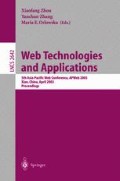Abstract
In this paper, a formal object-oriented semantic model for XSLT in Object-Z is presented. The semantic model is constructed based on XSLT’s W3C Working Draft (August 2002). Formal description of XSLT language can provide deeper understanding of the language and support the standardisation effort for XSLT. All XSLT language constructs are modeled as Object-Z classes and the XSLT stylesheet itself is also specified by a formal class. This highly structured semantic model is concise, composable and extensible.
This paper was written during the first author’s visit to the School of Computing of National University of Singapore as part of the UNU/IIST Fellowship Programme.
Access this chapter
Tax calculation will be finalised at checkout
Purchases are for personal use only
Preview
Unable to display preview. Download preview PDF.
References
Scott Boag etc. Anders Berglund. XML Path Language (XPath) 2.0, 2002. http://www.w3.org/TR/xpath20/.
James Clark. XSL Transformations (XSLT) Version 2.0, 2002. http://www.w3.org/TR/xslt20/.
J. S. Dong. Formal Object Modelling Techniques and Denotational Semantics Studies. PhD thesis, University of Queensland, 1995.
J. S. Dong, R. Duke, and G. Rose. An object-oriented approach to the semantics of programming languages. Australian Computer Science Communications, 16, 1994.
R. Duke and G. Rose. Formal Object Oriented Specification Using Object-Z. Macmillan, 2000.
Denise Draper etc. XQuery 1.0 and XPath 2.0 Formal Semantics, 2002. http://www.w3.org/TR/query-semantics/.
J. Sun, J. S. Dong, J. Liu, and H. Wang. Object-ZWeb Environment and Projections to UML. In WWW-10: 10th International World Wide Web Conference, refereed papers track, pages 725–734. ACM Press, May 2001.
C. M. Sperberg-McQueen Tim Bray, Jean Paoli. Extensible Markup Language (XML) 1.0 (Second Edition), 2000. http://www.w3.org/TR/REC-xml/.
P. Wadler. A formal semantics of patterns in XSLT, Markup Languages, MIT Press, June 2001.
Author information
Authors and Affiliations
Editor information
Editors and Affiliations
Rights and permissions
Copyright information
© 2003 Springer-Verlag Berlin Heidelberg
About this paper
Cite this paper
Yang, H.L., Dong, J.S., Hao, K.G., Han, J.G. (2003). Formalizing Semantics of XSLT Using Object-Z. In: Zhou, X., Orlowska, M.E., Zhang, Y. (eds) Web Technologies and Applications. APWeb 2003. Lecture Notes in Computer Science, vol 2642. Springer, Berlin, Heidelberg. https://doi.org/10.1007/3-540-36901-5_13
Download citation
DOI: https://doi.org/10.1007/3-540-36901-5_13
Published:
Publisher Name: Springer, Berlin, Heidelberg
Print ISBN: 978-3-540-02354-8
Online ISBN: 978-3-540-36901-1
eBook Packages: Springer Book Archive

